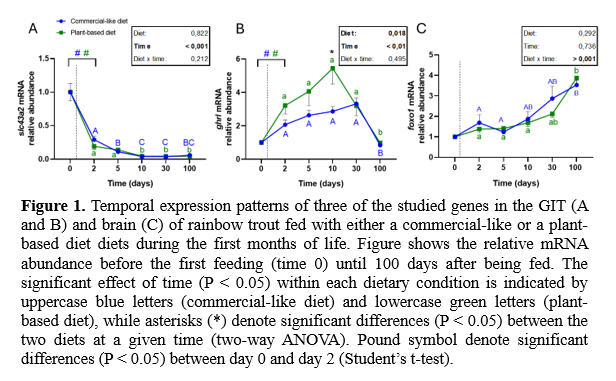TEMPORAL EVOLUTION OF mRNA ABUNDANCE OF APPETITE-REGULATING GENES IN THE GASTROINTESTINAL TRACT AND BRAIN OF RAINBOW TROUT Oncorhynchus mykiss FED A PLANT-BASED DIET FROM FIRST FEEDING
Introduction
In order to promote sustainable aquaculture practices, fishmeal and fish oil from aquafeeds are being progressively replaced with plant-based alternatives. However, this substitution may negatively affect carnivorous species, such as rainbow trout (Oncorhynchus mykiss), especially during early developmental stages (Lazzarotto et al., 2018). The underlying molecular mechanisms of these effects are not yet fully understood. To shed light on this, the aim of this study was to characterize the temporal evolution of the mRNA abundance of amino acid sensing systems in the gastrointestinal tract (GIT) and of appetite-regulatory genes in the brain of rainbow trout from the first feeding, as well as to evaluate the putative modulation of such temporal profiles of a plant-based diet.
Materials and methods
Rainbow trout juveniles were fed two experimental diets from the first feeding until 100 days: a control diet similar to a commercial feed (containing a mix of fishmeal and plant meal), and a 100 % plant-based diet. Samples of the GIT and brain were collected on days 0 (before the first meal) and 2, 5, 10, 30, and 100 post-initiation of feeding. The abundance of genes related to amino acid sensing and appetite-regulatory hormones in the GIT and to feed intake regulation in the brain was quantified by quantitative PCR (qPCR).
Results and discussion
Trout fed the plant-based diet exhibited lower feed intake levels compared to those fed the commercial-like diet, resulting in reduced final growth. This difference may be attributed to a lower palatability of the plant-based diet, possibly due to anti-nutritional factors or differences in nutrient composition, or to a putative alteration of nutrient sensing mechanisms and feed motivation, ultimately affecting central regulation in the long term.
Regarding amino acid sensing mechanisms, the commercial-like diet induced an increase in the mRNA abundance of one of the studied receptors (tas1r2a) at the onset of feeding, although no major changes were then observed throughout development. As for amino acid transporters, the first feeding with either a commercial-like or plant-based diet modulated the mRNA abundance of slc43a2 and slc1a5. Subsequently, increasing mRNA abundance over time was observed for slc6a19, slc15a1, and slc1a1, while decreasing mRNA levels at early stages were found for slc7a9 and slc43a2 (Fig. 1A). No major differences in the temporal mRNA abundance profile were observed between diets (except for slc1a5).
The onset of feeding (with one or both diets) caused a significant increase in the mRNA levels of almost all gastrointestinal hormones (ghrl, gcg, pyy) (Fig. 1B). At early developmental stages, an increase in mRNA abundance was observed for all hormones, which may reflect the need to regulate feeding through the overexpression of appetite-regulating hormones. However, a decrease in abundance was observed at late stages, which could be attributed to more precise hormonal regulation due to the maturation of these mechanisms.
At the central level, all neuropeptides exhibited significant changes at the onset of feeding, with one or both diets. After the initial feeding, npy and cartpt (particularly with the control diet) increased progressively throughout development, whereas agrp and pomc showed a decreasing trend over time. Additionally, the expression of key components of integrative signalling pathways (prkaa2, mtor, creb1, foxo1) increased during growth (Fig. 1C), although their abundance was differentially modulated depending on the dietary treatment. Furthermore, no major differences between diets were observed, except for mtor.
Conclusions
This study provides the first description of the mRNA abundance of appetite-regulating mechanisms in the GIT and brain of rainbow trout from first feeding up to 100 days. The results indicate distinct temporal gene expression patterns in both tissues, with almost no significant dietary (commercial-like vs. plant-based diet) effects during early developmental stages. This suggests that reduced feed intake and growth impairments associated with vegetable diets may be due to other physiological mechanisms. These findings are essential for optimizing feeding strategies in sustainable aquaculture.
Bibliografía
Lazzarotto, V., M´edale, F., Larroquet, L., Corraze, G., 2018. Long-term dietary replacement of fishmeal and fish oil in diets for rainbow trout (Oncorhynchus mykiss): effects on growth, whole body fatty acids and intestinal and hepatic gene expression. PLoS One 13, e0190730. https://doi.org/10.1371/journal.pone.0190730.
Acknowledgments
This research was funded by the Spanish Agencia Estatal de Investigación and European Fund of Regional Development (PID2022-136288OB-C31) and Xunta de Galicia (ED431B 2022/01) to J.L. Soengas, and by the French National Research Agency (ANR-21-CE20-0009-01) to J. Roy.
